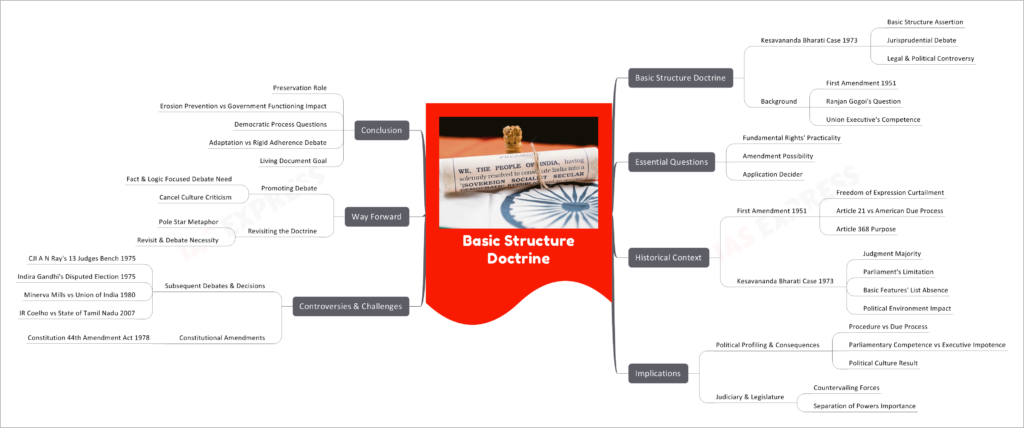Basic Structure Doctrine- Background, Implications & Challenges

From Current Affairs Notes for UPSC » Editorials & In-depths » This topic
IAS EXPRESS Vs UPSC Prelims 2024: 80+ questions reflected
The Indian Constitution is a living document that has undergone several amendments since its inception. One significant aspect of the Indian Constitution is the ‘Basic Structure Doctrine,’ which emerged from the landmark Kesavananda Bharati case in 1973. This doctrine asserts that the Parliament cannot alter the basic structure of the Constitution through amendments. The discussion around this doctrine and its jurisprudential basis has been a topic of debate and controversy in Indian politics and legal circles.

The Debate on the Basic Structure Doctrine
Background
- The debate dates back to 1951 during the discussion on the First Amendment of the Constitution, revolving around the right of a free nation to shape its present and determine its future, unhindered by external values or received ideas.
- Recently, the debate was resuscitated by Ranjan Gogoi, who questioned the jurisprudential basis of the Basic Structure Doctrine. He noted that this doctrine has a “very debatable jurisprudential basis.”
- The issue was also linked to the competence of the Union executive, acting through Parliament, to curtail the power of the Delhi Government over services. This move seemed to contravene current judicial practice, affecting the federal balance, a key component of the Basic Structure Doctrine.
Essential Questions
- How fundamental are specific fundamental rights in practice?
- Can such rights be amended?
- Who would have the last word on their application?
The Historical Context
First Amendment, 1951
- In 1951, Parliament debated the First Amendment, seeking curtailment of the fundamental right to freedom of expression.
- Article 21 of the Constitution privileges “procedure established by law” over American-style “due process.”
- Article 368 was designed as a joint mechanism to keep the state and society in sync through suitable and incremental amendments to the Constitution.
Kesavananda Bharati Case, 1973
- The Basic Structure Doctrine emerged from the Kesavananda Bharati judgment delivered by a majority of 7:6 on April 24, 1973.
- The court held that Parliament could not alter the basic structure of the Constitution by an amendment.
- There is no exclusive and definitive list of basic features; the judiciary decides this on a case-by-case basis.
- This doctrine has created a peculiar political environment where the executive remains hamstrung, constrained by limited material resources and uncertain legal room to maneuver.
Implications of the Doctrine
Political Profiling and Consequences
- The Basic Structure Doctrine puts “procedure established by law” below “due process” in the functioning of the legislative process.
- It creates a gap between parliamentary competence and executive impotence, resulting in a political culture of grandstanding, empty rhetoric, and non-binding, unverifiable communication between politicians and the electorate.
The Judiciary and Legislature
- The countervailing forces of Indian politics, a watchful judiciary, and an empowered legislature, are built into the political system through the separation of powers.
- This separation of powers is crucial for the deepening and resilience of Indian democracy.
Controversies and Challenges
Subsequent Debates and Decisions
- In 1975, a bench of 13 judges was constituted by CJI A N Ray to debate the theory of basic structure and framework as propounded in the Kesavananda Bharati case.
- However, the bench was dissolved without a decision.
- In 1975, the Supreme Court resisted a legislative attempt at validation in the case of PM Indira Gandhi’s disputed election.
- In 1980, in the Minerva Mills vs Union of India case, and in 2007, in the IR Coelho vs State of Tamil Nadu case, the basic structure doctrine was unanimously reaffirmed by the Supreme Court.
Constitutional Amendments
- Parliament, by the Constitution 44th Amendment Act 1978, declared that Articles 20 and 21 of the Constitution could never be suspended, even during the proclamation of an Internal or External Emergency, thus accepting the basic structure doctrine.
Way Forward
Promoting Debate
- It is essential to have more debate, focused on facts and logic, rather than diffuse, emotive categories of love and hate.
- The “cancel culture” of foreclosing debate serves neither the cause of justice nor of democratic deepening and consolidation.
Revisiting the Doctrine
- The Basic Structure Doctrine, as the “Pole Star” of Indian politics, should be used wisely by navigators in the stormy nights of Indian politics.
- It is crucial to revisit and debate the doctrine to ensure that it serves its intended purpose without hampering the functioning of the government.
Conclusion
The Basic Structure Doctrine has played a crucial role in preserving the fundamental pillars of the Constitution. While it has helped in preventing the erosion of essential features of the Constitution, it has also raised questions about its impact on the functioning of the government and the democratic process. As India continues to navigate its way through its various challenges, it is essential to revisit and debate the doctrine, promoting a culture of discussion and adaptation rather than rigid adherence to past decisions. Ultimately, the goal should be to ensure that the Constitution remains a living document that evolves to meet the needs and aspirations of the people while preserving its core principles.
Practice Question for Mains
What is the Basic Structure Doctrine? Comment on its significance in preserving the Indian Constitution as a living document. (250 words)
If you like this post, please share your feedback in the comments section below so that we will upload more posts like this.

